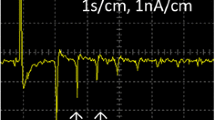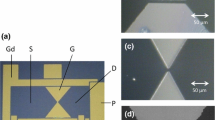Abstract
We investigate the formation of quantum confined structures on the surface of a liquid helium film suspended on a nanostructured substrate. We show theoretically that, by nanostructuring the substrate, it is possible to change the geometry of the liquid helium surface, opening the possibility of designing and controlling the formation of valleys with different shapes. By applying an external electric field perpendicular to the substrate plane, surface electrons can be trapped into these valleys, as in a quantum dot. We investigate how the external parameters, such as the electric field strength and the height of the liquid helium bath, can be tuned to control the energy spectrum of the trapped surface electrons.












Similar content being viewed by others
References
W.T. Sommer, Phys. Rev. Lett. 12, 271 (1964)
M. Cole, M.H. Cohen, Phys. Rev. Lett. 23, 1238 (1969)
V.B. Shikin, Sov. Phys. JETP 31, 936 (1970)
Yu.Z. Kovdrya, Low Temp. Phys. 29, 77 (2003)
P.M. Platzman, M.I. Dykman, Science 284, 1967 (1999)
G. Sabouret, F.R. Bradbury, S. Shankar, J.A. Bert, S.A. Lyon, Appl. Phys. Lett. 92, 082104 (2008)
A.J. Dahm, J.M. Goodkind, I. Karakurt, S. Pilla, J. Low Temp. Phys. 126, 709 (2002)
D.I. Schuster, A. Fragner, M.I. Dykman, S.A. Lyon, R.J. Schoelkopf, Phys. Rev. Lett. 105, 040503 (2010)
G. Papageorgiou, P. Glasson, K. Harrabi, V. Antonov, E. Collin, P. Fozooni, P.G. Frayne, M.J. Lea, D.G. Rees, Y. Mukharsky, Appl. Phys. Lett. 86, 153106 (2005)
A.V. Chaplik, JETP Lett. 31, 252 (1980)
A.M. Dyugaev, A.S. Rozhavskii, I.D. Vagner, P. Wyder, JETP Lett. 67, 434 (1998)
S. Mostame, R. Schützhold, Phys. Rev. Lett. 101, 220501 (2008)
Yu.P. Monarkha, S.S. Sokolov, A.V. Smorodin, N. Studart, Low Temp. Phys. 36, 565 (2010)
D. Rees, K. Kono, J. Low Temp. Phys. 158, 301 (2010)
D.G. Rees, I. Kuroda, C.A. Marrache-Kikuchi, M. Höfer, P. Leiderer, K. Kono, Phys. Rev. Lett. 106, 026803 (2011)
D.G. Rees, I. Kuroda, C.A. Marrache-Kikuchi, M. Höfer, P. Leiderer, K. Kono, J. Low Temp. Phys. 166, 107 (2012)
Yu.Z. Kovdrya, Yu.P. Monarkha, Fiz. Nizk. Temp. 12, 1011 (1986) [Sov. J. Low Temp. Phys. 12, 571 (1986)]
A.M.C. Valkering, J. Klier, E. Teske, R.W. van der Heijden, P. Leiderer, J. Low Temp. Phys. 113, 1115 (1998)
A.C.A. Ramos, A. Chaves, G.A. Farias, F.M. Peeters, Phys. Rev. B 77, 045415 (2008)
P.K.H. Sommerfeld, R.W. van der Heijden, J. Phys. Condens. Matter 7, 9731 (1995)
A.C.A. Ramos, O.G. Balev, N. Studart, J. Low Temp. Phys. 138, 403 (2005)
W.H. Press, B.P. Flannery, S.A. Teukolsky, W.T. Vetterling, Numerical Recipes in Fortran 77, 2nd edn. (1992)
F.M. Peeters, in Proc. of NATO Workshops on Science and Engineering of One and Zero Dimensional Semiconductors, ed. by S.P. Beaumont, C.M. Sotomayor Torres (Plenum, New York, 1990), p. 107
S.S. Sokolov, G.-Q. Hai, N. Studart, Phys. Rev. B 51, 5977 (1995)
S.S. Sokolov, N. Studart, Phys. Rev. B 51, 2640 (1995)
R.C.T. da Costa, Phys. Rev. A 23, 1982 (1981)
V.B. Shikin, Yu.P. Monarkha, J. Low Temp. Phys. 16, 193 (1974)
S.S. Sokolov, G.-Q. Hai, N. Studart, Phys. Rev. B 52, 15509 (1995)
T.I. Zueva, S.S. Sokolov, Low Temp. Phys. 38, 185 (2012)
G.A. Farias, R.N. Costa Filho, F.M. Peeters, N. Studart, Phys. Rev. B 64, 104301 (2001)
M.H. Degani, G.A. Farias, F.M. Peeters, Phys. Rev. B 72, 125408 (2005)
U. Merkt, J. Huser, M. Wagner, Phys. Rev. B 43, 7320 (1991)
M. Wagner, U. Merkt, A.V. Chaplik, Phys. Rev. B 45, 1951 (1992)
R.B. Laughlin, Phys. Rev. B 27, 3383 (1983)
F.M. Peeters, V.A. Schweigert, Phys. Rev. B 53, 1468 (1996)
L.A. Tracy, E.P. Nordberg, R.W. Young, C. Borrás Pinilla, H.L. Stalford, G.A. Ten Eyck, K. Eng, K.D. Childs, J.R. Wendt, R.K. Grubbs, J. Stevens, M.P. Lilly, M.A. Eriksson, M.S. Carroll, Appl. Phys. Lett. 97, 192110 (2010)
Acknowledgements
This work has received financial support from the Brazilian National Research Council (CNPq), Fundação Cearense de Apoio ao Desenvolvimento Científico e Tecnológico (Funcap), CAPES and Pronex/CNPq/Funcap. This work was partially supported by the Flemish Science Foundation (FWO-Vl) and the bilateral project between CNPq and FWO-Vl.
Author information
Authors and Affiliations
Corresponding author
Appendices
Appendix A: Smoothness of the Surface Profile
In order to obtain Eq. (2), one must consider that the surface profile ξ(x,y) varies smoothly. If such an approximation is not considered, one obtains the following equation for the surface profile:
where
Indeed, if (∂ξ/∂x)2≪1, (∂ξ/∂y)2≪1 and (∂ξ/∂x)(∂ξ/∂y)≪1, Eq. (12) approaches Eq. (5), as expected. Among all the systems investigated in this work, the maximum value observed for the derivatives of ξ is ≈0.06, which would lead to squared derivatives of order of ≈0.0036 in the worst case scenario. This is still around three orders of magnitude smaller than 1, which guarantees that κ x , κ y and κ xy in Eqs. (12) and (13) can be fairly well approximated to 1 and, therefore, validates Eq. (5) for all systems studied in this paper.
Appendix B: Two-Electrons in a Parabolic Quantum Dot
For two interacting electrons in a parabolic dot subjected to an external magnetic field, the Hamiltonian reads
To solve the Schrödinger equation for this Hamiltonian, we must change the coordinates system, so that it becomes separable. Using the center-of-mass \(\vec{R}=(\vec{r_{1}}+\vec{r_{2}})/2\) and relative \(\vec {r}=\vec{r_{1}}-\vec{r_{2}}\) coordinates system, the Hamiltonian for this system is re-written as H=H r +H R , where
and
with \(q=\frac{e}{2}\), \(\mu=\frac{1}{2}m\), Q=2e and M=2m. Besides, the introduction of this coordinates system gives rise to different momentum operators
Assuming the potential vector \(\vec{A}\) as the symmetric gauge, for a magnetic field applied in z-direction, one finds
where ω c is the cyclotron frequency and \(\omega^{2}=\omega ^{2}_{0}+\omega^{2}_{c}/4\).
The separability of the Schrödinger equation allow us to write two-particle wave function in the form \(\varPsi(\vec{r},\vec{R})=\varPsi _{r}(\vec{r})\varPsi_{R}(\vec{R})\) and to separate the Schrödinger equation for the Hamiltonian equation (14) into two eigenvalue equations
Assuming \(\varPsi_{R}(\vec{R})=\varGamma(R)\varPhi(\phi)\) and \(\varPsi _{r}(\vec{r})=\varUpsilon(r)\varOmega(\varphi)\), one takes advantage of the circular symmetry of the problem to solve it for ϕ and φ as Φ(ϕ)=e iLϕ and Ω(φ)=e ilφ. As the wave function must be periodic in the angular direction, it is obtained that L,l=0,±1,±2,… .
The equation for radial part of the center of mass, Γ(R), can be reduced, after a few transformations, to a generalized Laguerre equation
where ζ=R 2/2a 2 with \(a=\sqrt{\hbar/2M\omega}\) and \(\varGamma(R) = e^{-\frac{\zeta}{2}}\zeta^{\frac{|L|}{2}}F(\zeta)\). For the eigenfunctions to converge, the last term which multiplies F(ζ) in Eq. (23) should be an integer, thus we obtain for the eigenenergies
where N is an integer.
Unfortunately the equation for ϒ(r) cannot be solved by analytical methods, therefore we appeal to a numerical method [35] based on a finite differences scheme. The equation we intend to solve can be written in a dimensionless form as
where space and energy variables were divided by the Bohr radius a 0 and the Rydberg energy R y , respectively. By numerically solving this equation, one obtains the contribution of the relative coordinates ε r to the eigenenergy of the system E=ε R +ε r .
Rights and permissions
About this article
Cite this article
Dantas, D.S., Chaves, A., Farias, G.A. et al. Low-Dimensional Confining Structures on the Surface of Helium Films Suspended on Designed Cavities. J Low Temp Phys 173, 207–226 (2013). https://doi.org/10.1007/s10909-013-0895-5
Received:
Accepted:
Published:
Issue Date:
DOI: https://doi.org/10.1007/s10909-013-0895-5




